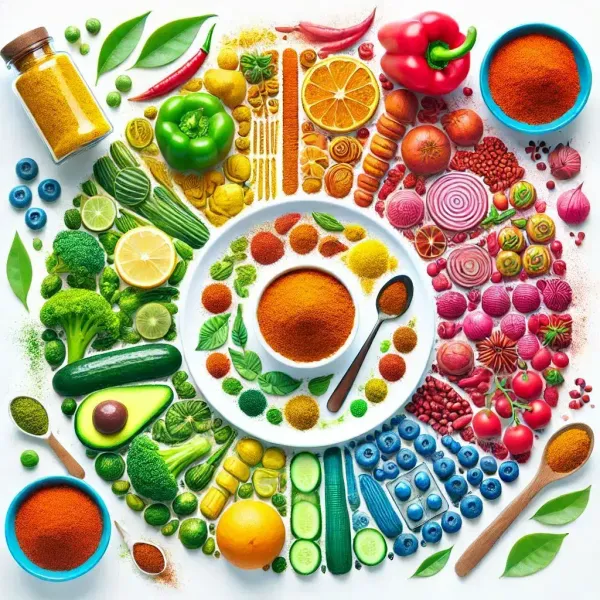Emerging Trends in the Health and Nutrition Sector 2025: The Ultimate Guide
Seven key trends are reshaping health and nutrition in 2024, focusing on sustainability and personalization.

Hey, it's Clark Clifford here. And in today's post, I'll reveal 7 game-changing trends that are reshaping the health and nutrition industry in 2025. Discover new nutrition and whole health solutions for everyday use, from plant-based innovations to digital health integration.
Whether you're a health-conscious consumer or a nutrition professional, these trends will change your outlook.
From plant-based innovations to AI-powered personalized diets, I've spent a lot of time researching and testing new food trends to create this guide for you.
In his groundbreaking book "Food Politics How the Food Industry Influences Nutrition and Health," Marion Nestle shows how big food companies secretly influence what we eat and our public health policies.
So if you want to stay ahead of the curve and optimize your health (or your clients'), you are in the right place.
Let's dive in.
1. Plant-Based Innovations
Eating Whole, Plant-Based Foods (WFPB) Can Give You More Energy, Prevent Health Problems, and Help You Live Healthier.
The plant-based innovation market continues to evolve rapidly, with new ingredients and formulations driving innovation:
- Novel protein sources: Emerging options like microalgae, mycoprotein, and cell-cultured meat alternatives are gaining traction.
- Texture improvement: Advanced processing techniques are creating plant-based products with more meat-like textures and mouthfeel.
- Nutrient fortification: Manufacturers enhance plant-based products with vitamins, minerals, and omega-3s to match or exceed the nutritional profile of animal-based counterparts. Plant-based foods are being made healthier by adding vitamins, minerals, and omega-3s to match or beat animal-based foods. Plant-based products are being enhanced with vitamins, minerals, and omega-3s to match or exceed the nutritional profile of animal-based counterparts.
Here are 3-4 tips for taking advantage of plant-based innovation trends for both humans and pets:
For Humans:
- Experiment with novel plant proteins: Try new plant proteins like seitan, tempeh, textured vegetable protein (TVP), or pea protein products in your meals to add variety. Although seitan may not be good for those with gluten intolerance, and peas contain lectins.
- Explore meat alternatives: Test different plant-based burgers, sausages, and other meat substitutes to find ones you like.
- Read nutrition labels: Check food labels for added vitamins B12, D, omega-3s, and iron in plant-based products to meet your needs.
- Try plant-based dairy alternatives: Try different non-dairy milks, yogurts, and cheeses to find ones you like that are good for you.
For Pets:
- Gradually introduce plant-based innovation pet foods: Slowly mix plant-based pet foods into your pet's regular food to help their digestion adjust.
- Look for complete and balanced formulas: Choose certified nutritionally complete plant-based pet foods to ensure your pet receives all necessary nutrients.
- Offer plant-based treats: Introduce vegetable-based treats or snacks as a way to incorporate more plant foods into your pet's diet.
- Consult your veterinarian: Talk to your vet about switching your pet to a more plant-based food innovation diet to make sure it's safe and get personal advice.
2. Clean Label Evolution
Consumer demand for transparency and simplicity in ingredients remains strong:
- Minimal processing: Brands are focusing on gentle processing methods to preserve nutrients and natural flavors.
- Natural preservatives: Plant-based extracts and fermentation-derived ingredients are replacing synthetic preservatives.
- Functional ingredients: Clean label products are incorporating recognizable superfoods and adaptogens for added health benefits.
Here are 3-4 tips for taking advantage of the clean label evolution trend for both humans and pets:
For Humans:
- Read ingredient labels carefully: Read food labels carefully and choose products with simple, familiar ingredients and no artificial additives.
- Choose minimally processed foods: Pick whole foods and products that are minimally processed to keep their natural nutrients and flavors.
- Experiment with natural preservatives: When cooking at home, try using vinegar, lemon juice, or rosemary extract as natural preservatives.
- Incorporate functional ingredients: Add recognizable superfoods like chia seeds, berries, or turmeric to your meals for added health benefits.
For Pets:
- Switch to clean label pet foods: Look for pet food brands that use natural, whole ingredients and avoid artificial additives.
- Make homemade pet treats: Make simple pet treats at home using safe, whole ingredients so you know exactly what's in them.
- Use natural grooming products: Choose pet shampoos and grooming products with plant-based ingredients and without harsh chemicals.
- Introduce functional ingredients gradually: Slowly incorporate pet-safe superfoods like pumpkin, blueberries, or salmon oil into your pet's diet for added nutritional benefits.
3. Personalized Nutrition
Advancements in tailoring the science of nutrition to enable more personalized nutrition coaching approaches:
- Genetic testing: Nutrigenomics is informing personalized dietary recommendations based on individual genetic profiles.
- Microbiome analysis: Gut health testing is guiding probiotic and prebiotic supplementation strategies.
- AI-powered apps: Machine learning algorithms are providing real-time nutritional guidance based on personal health data.
Here are 3-4 tips for taking advantage of the personalized nutrition trend for both humans and pets:
For Humans:
- Get genetic testing done: Consider using services like 23andMe or AncestryDNA that offer health and ancestry reports. These can provide insights into your genetic predispositions related to nutrition and health.
- Track your diet and symptoms: Use a food diary app to log your meals and any symptoms you experience. This can help identify potential food sensitivities or intolerances.
- Try a microbiome test: Companies like Viome or Thryve offer at-home gut microbiome testing kits. The results can guide you in choosing foods and supplements for gastro health and nutrition.
- Consult a nutritionist: Work with a registered dietitian specializing in optimal whole health and nutrition to understand your test results and create a personalized eating plan.
For Pets:
- DNA test your pet: Use pet DNA tests like Embark or Wisdom Panel to learn about your pet's breed-specific food needs and health risks.
- Monitor your pet's diet and health: Keep a log of your pet's food intake, energy levels, and any health issues. This can help identify patterns and inform dietary adjustments.
- Consider a personalized pet food service: Try custom pet food services like Just Food For Dogs or NomNomNow that make meals based on your pet's age, weight, and health.
- Regular vet check-ups: Visit your vet regularly to discuss your pet's food needs and any diet changes based on their health and test results.
4. Functional Foods and Beverages
Products with targeted health benefits are seeing increased consumer interest:
- Cognitive health: Ingredients like omega-3s, B vitamins, and nootropic compounds are being added to support brain function.
- Immune support: Formulations featuring vitamins C and D, zinc, and adaptogenic herbs are gaining popularity.
- Mood and stress management: Products containing L-theanine, ashwagandha, and CBD are addressing mental well-being.
Here are 3-4 tips for taking advantage of the functional foods and beverages trend for both humans and pets:
For Humans:
- Choose minimally processed foods: Opt for whole foods and products that use gentle processing methods to retain natural nutrients and flavors and are produced using verifiable supply routes.
- Try adaptogenic beverages: Try drinks with herbs like ashwagandha or rhodiola, which may help reduce stress and improve mood.
- Explore nootropic supplements: Consider trying supplements or foods with L-theanine or bacopa, which might help brain function.
- Boost your immune system: Look for foods and drinks with added vitamins C and D, zinc, and elderberry to boost your immune system.
For Pets:
- Choose cognitive-supporting pet foods: Choose pet foods with DHA (an omega-3) or antioxidants, which may help older pets' brain health.
- Offer calming treats: Give your pet treats with L-theanine or chamomile, which might help reduce their stress and anxiety.
- Supplement with immune-boosting products: Add pet supplements with vitamins C and E, or probiotics for optimum health and nutrition to support your pet's immune system.
- Introduce functional toppers: Add food toppers to your pet's meals with ingredients like turmeric or green-lipped mussel for joint health.
5. Sustainable and Upcycled Ingredients
Environmental concerns are driving innovation in ingredient sourcing:
- Upcycled foods: Ingredients derived from food manufacturing byproducts are reducing waste and adding nutritional value.
- Regenerative agriculture: Brands are highlighting ingredients sourced from farms using soil-friendly practices.
- Alternative proteins: Insects and single-cell proteins are emerging as sustainable protein sources.
Here are some tips for using sustainably sourced ingredients and upcycled ingredients for both people and pets:
For Humans:
- Look for upcycled food products: Look for brands upcycling ingredients, like snacks made from fruit peels or flour from used grains.
- Support regenerative agriculture: Choose sustainable ingredients examples sourced from regenerative farms or that highlight soil-friendly farming practices.
- Experiment with alternative proteins: Try eating insect-based proteins or single-cell proteins as eco-friendly alternatives to regular meat.
- Reduce food waste at home: Upcycle ingredients by composting food scraps or finding new ways to use leftover ingredients in recipes.
For Pets:
- Choose pet foods with upcycled ingredients: Choose pet foods that use upcycled ingredients like vegetable pulp or spent grains.
- Opt for sustainable protein sources: Pick pet foods that use eco-friendly proteins like insects or new plant proteins.
- Make homemade treats: Create pet treats using leftover ingredients from your own cooking to reduce food waste and provide healthy snacks for your pet.
- Support eco-friendly pet brands: Buy pet products made from sustainable or recycled materials, like toys made from recycled plastic.
What Does Upcycling Ingredients Mean?
Upcycling ingredients is transforming food waste into valuable new products. Smart companies are waking up to this opportunity to reduce waste and create innovative offerings.
What Are Upcycled Ingredients?
Upcycled ingredients are materials that would have been discarded but are instead repurposed into nutritious, usable food items. Think of fruit pulp from juice production being turned into fiber-rich snacks or spent grains from breweries becoming protein-packed flours.
New products from upcycled food or ingredients are hitting the market at a rapid pace. Savvy brands are meeting customer demand for eco-friendly options while also reducing food waste.
What Are Sustainable Ingredients?
They're foods produced with minimal environmental impact. A sustainable ingredient conserves resources, protects ecosystems, and supports communities. It's the future of our food system.
Food loss and waste is a critical issue plaguing our food system. About one-third of all food produced globally ends up lost or wasted. This includes significant amounts of animal products. It's an inefficiency we can't afford.
Forward-thinking companies are creating a wide range of innovative products from upcycled ingredients. From snacks to beverages to baking mixes, the possibilities are endless.
The food industry must embrace upcycling and sustainability to meet growing demand. Consumers want eco-friendly options. Brands that act now to incorporate upcycled and sustainable ingredients will be gaining a competitive edge.
Don't get left behind. The upcycled ingredient trend is here to stay. Consider offering a new product from upcycled food or ingredients.
Position your brand as a leader in sustainability and capture market share. The opportunity is ripe for those who move quickly and decisively.
6. Advancements in Nutritional Science
Ongoing research is uncovering new insights into nutrition and whole health solutions:
- Gut-brain axis: Studies are revealing the complex relationship between gut health and cognitive function.
- Chrononutrition: Research on meal timing and circadian rhythms is informing optimal eating patterns.
- Nutrient synergies: Understanding how different nutrients interact is leading to more effective formulations.
Here are some tips for using new nutrition basics for better health and performance of both people and pets:
For Humans:
- Prioritize gut health: Eat fermented foods like yogurt, kefir, or sauerkraut to support a healthy gut microbiome, which may help brain function.
- Practice time-restricted eating: Try eating only during an 8-12 hour window each day to match your body's natural rhythms.
- Combine complementary nutrients: Pair iron-rich foods with vitamin C to absorb more iron, or eat turmeric with black pepper to increase curcumin benefits.
- Stay informed: Follow trusted nutrition science sources or talk to a dietitian to learn about the latest food research.
For Pets:
- Introduce probiotics: Add pet probiotics to your pet's food to support gut health and overall wellness.
- Establish consistent feeding times: Feed your pet at the same times each day to match their natural body rhythms and help digestion.
- Choose balanced pet foods: Choose pet foods made with ingredients from verifiable supply chains and balanced nutrients, like omega-3s paired with antioxidants.
- Consult your veterinarian: Talk to your vet about new pet nutrition research to see if any diet changes could help your pet's health.
7. Digital Health Integration
Technology is playing an increasingly important role in nutrition management:
- Wearable devices: Continuous glucose monitors and other sensors are providing real-time data on nutritional status.
- Virtual nutritionist platforms: AI-powered chatbots and telehealth services are making personalized nutrition advice more accessible.
- Blockchain traceability: Supply chain transparency is being enhanced through blockchain technology.
Here are 3-4 tips for taking advantage of digital health integration trends for both humans and pets:
For Humans:
- Use a wearable health tracker: Use a smartwatch or fitness tracker to monitor your heart rate, sleep, and activity. Use this data to set health goals and track progress over time.
- Try a nutrition app: Use a nutrition app to track your meals, calories, and get personalized diet advice.
- Explore telehealth options: Look into virtual consultations with nutritionists or dietitians through telehealth platforms. This can provide convenient access to personalized nutrition advice from the comfort of home.
- Research food traceability: Look for food brands that show where their ingredients come from using technology like blockchain.
For Pets:
- Use a smart pet collar: Try a GPS pet collar that tracks your pet's activity, sleep, and location. Use this data to ensure your pet is getting enough exercise.
- Try an automated pet feeder: Use a smart pet feeder you can control with your phone to give the right amount of food on schedule.
- Explore virtual vet consultations: Look into online vet consultations for quick advice on non-emergency pet issues.
- Use a pet health tracking app: Download an app designed to track your pet's health metrics, vaccination schedules, and dietary needs. This can help you stay on top of your pet's overall health and nutrition.
8. Conclusion
Staying informed about these new trends helps professionals meet changing customer needs and create new products. Attending events like SupplySide West, with over 135 hours of expert talks, helps professionals stay up-to-date.
Wake up, food industry! The game is changing. Consumers are demanding more than just tasty treats. They're looking for nutrition health and wellness in every bite.
Smart companies are slashing their carbon footprint. Why? Because globally food production accounts for a third of all greenhouse gases. That's a problem we can't ignore.
The United States, a major player in the global food supply, must lead the charge. We need to rethink how we source and use raw materials. It's not just about profit anymore. It's about planet and people.
Gluten-free products were just the beginning. Now, consumers want foods that are good for them and the earth. They're voting with their wallets, and the message is clear: sustainability sells.
But here's the kicker: you can't fake it. Greenwashing won't cut it. Consumers are savvy. They want real action, not just pretty packaging.
The winners in this new food landscape will be those who embrace change. They'll innovate with sustainable ingredients. They'll slash waste. They'll create products that nourish bodies and protect the planet.
Don't be left behind. The future of food is here. It's nutritious, it's sustainable, and it's what consumers want. Are you ready to step up to the plate?
Now It's Your Turn
There you have it: 7 game-changing trends that are reshaping the nutrition and whole health solutions landscape in 2025.
These trends, from plant-based innovations to AI-powered personalized diets, will change how we approach health for people and pets.
But remember: knowing about these trends is just the first step. The real magic happens when you start implementing them in your life (or your pet's life).
So now I want to turn it over to you:
Which of these trends are you most excited about?
Is it the rise of functional foods?
The potential of personalized nutrition?
What is a sustainable ingredient?
Or maybe the advancements in digital health integration?
Let me know by leaving a comment below right now.
And while you're at it, I've got a quick question for you:
Which of these trends do you think will have the biggest impact on the health and nutrition industry in the next 5 years?
- A) Plant-Based Innovation
- B) Personalized Nutrition
- C) Digital Health Integration
- D) Sustainable and Upcycled Ingredients
Drop your answer in the comments section at the bottom of the page. I'm looking forward to hearing your thoughts!
From 2024 to 2025, the health and nutrition sector has seen significant shifts driven by consumer preferences, technological advancements, and sustainability concerns. Below are the key trends shaping this space:
Key Trends in Health and Nutrition (2024–2025)
1. Personalized Nutrition
Advancements in artificial intelligence (AI) and wearable health technology are enabling highly personalized dietary recommendations. AI-powered tools analyze genetic, microbiome, and lifestyle data to create tailored nutrition plans. This trend reflects the growing demand for customized solutions that address individual health needs, such as gut health, cognitive function, or sports performance.
2. High-Protein Diets
Protein continues to dominate consumer preferences, with an emphasis on both animal-based and plant-based sources. The rise of plant-based protein options is particularly notable, driven by environmental concerns and health benefits. Products like Greek yogurt, nuts, beans, and plant-based protein powders are increasingly popular.
3. Gut Health and Digestive Wellness
Gut health remains a top priority for consumers, with probiotics and prebiotics seeing widespread adoption. Fermented foods like kimchi and kombucha are becoming mainstream, while functional beverages containing gut-friendly ingredients are gaining traction. This focus stems from the growing understanding of the gut-brain connection and its impact on overall well-being.
4. Functional Foods and Beverages
Functional water and other beverages infused with vitamins, minerals, adaptogens, or probiotics are expanding rapidly. These products aim to provide benefits beyond hydration, such as improved digestion or stress relief.
5. Healthy Aging
Consumers are increasingly seeking foods that promote longevity and healthy aging. Diets inspired by "Blue Zones" (regions with high life expectancy) emphasize whole foods, legumes, and minimal meat consumption. Anti-inflammatory diets rich in fruits, vegetables, nuts, and omega-3 fatty acids are also gaining popularity for their role in reducing cognitive decline.
6. Sustainable Nutrition
Sustainability is a megatrend influencing product development across the industry. Consumers are prioritizing eco-friendly food options that balance nutritional needs with environmental impact. This includes plant-based diets, reduced food waste initiatives, and sustainable packaging solutions.
7. Weight Management Innovations
Weight management remains a key focus area, particularly with the rise of GLP-1 medications like Ozempic. Natural weight-loss solutions—such as high-protein diets or low-sugar alternatives—are being marketed as complementary or standalone options.
8. Cognitive Health
Foods and supplements targeting brain health are gaining attention as consumers seek ways to enhance memory and cognitive function. Nootropics (cognitive enhancers) and diets rich in omega-3s are central to this trend.
9. Affordability in Nutrition
Economic pressures have pushed consumers toward budget-friendly yet nutritious options like canned foods and shelf-stable pantry staples. These products offer convenience without compromising on health benefits[2][8].
10. Gender-Specific Nutrition
Genderized nutrition is emerging as a niche market segment, with products tailored to women's hormonal cycles or specific life stages such as pregnancy or menopause.
Conclusion
The health and nutrition sector is evolving to meet diverse consumer demands for personalization, sustainability, and functionality. From AI-driven dietary tools to gut-friendly foods and sustainable practices, these trends highlight a shift toward holistic well-being that balances individual needs with global challenges.
9. Citations
Plant Based Innovation
[2] https://www.webmd.com/diet/plant-based-diet
[3] https://mcpress.mayoclinic.org/nutrition-fitness/steps-to-start-eating-plant-based/
[4] https://www.nomeatathlete.com/make-it-stick/
[5] https://www.parkview.com/blog/transitioning-to-a-plant-based-diet-%E2%80%93-tips-and-tricks
Clean Label Evolution
[1] https://www.foodbev.com/news/keep-it-clean-the-shift-towards-transparency-in-the-food-industry
[4] https://www.foodnavigator.com/Article/2022/08/04/How-is-the-clean-label-trend-evolving-Mintel
[5] https://www.linkedin.com/pulse/clean-label-evolution-defensive-formulations-purposeful-inclusion
[8] https://www.new-nutrition.com/keytrend?id=304
Personalized Nutrition
[1] https://www.frontiersin.org/journals/psychology/articles/10.3389/fpsyg.2021.575465/full
[2] https://www.ncbi.nlm.nih.gov/pmc/articles/PMC6081996/
[3] https://fortune.com/well/article/personalized-precision-nutrition/
[4] https://foodinsight.org/personalized-nutrition-ready-for-prime-time/
[5] https://www.lumen.me/blog/personalized-nutrition-what-is-it-how-to-use-it-to-your-advantage
[6] https://medicalxpress.com/news/2024-05-personalized-nutrition-effective-general-diet.html
[8] https://zoe.com/learn/what-is-personalized-nutrition
Functional Foods and Beverages
[1] https://www.todaysdietitian.com/newarchives/JJ20p40.shtml
[2] https://www.ncbi.nlm.nih.gov/pmc/articles/PMC10083484/
[3] https://www.ifm.org/news-insights/nutrition-cognitive-health/
[4] https://www.ncbi.nlm.nih.gov/pmc/articles/PMC7690784/
[5] https://www.health.harvard.edu/healthbeat/foods-linked-to-better-brainpower
[6] https://www.unitypoint.org/news-and-articles/15-brain-foods-that-may-help-preserve-your-memory
[8] https://www.frontiersin.org/journals/psychology/articles/10.3389/fpsyg.2021.575465/full
Sustainable and Upcycled Ingredients
[1] https://www.mccormickfona.com/articles/2023/05/ingredient-hot-list---upcycled-ingredients
[2] https://www.foodbusinessnews.net/articles/23601-upcycled-ingredient-development-on-the-upswing
[3] https://natrue.org/circular-beauty-upcycled-ingredients-in-cosmetic-products/
[4] https://foodtank.com/news/2024/04/companies-creating-upcycled-food-from-waste-products/
[6] https://www.upcycledfood.org/upcycled-food
Advancements in Nutritional Science
[1] https://www.ncbi.nlm.nih.gov/pmc/articles/PMC6469458/
[2] https://www.sciencedirect.com/science/article/pii/S2352345X18300602
[3] https://www.ncbi.nlm.nih.gov/pmc/articles/PMC4367209/
[4] https://academic.oup.com/proteincell/article/14/10/762/7160035
[5] https://www.nature.com/articles/s41392-024-01743-1
[6] https://www.nature.com/articles/s41582-022-00681-2
[7] https://www.ncbi.nlm.nih.gov/pmc/articles/PMC7690784/
[8] https://www.ncbi.nlm.nih.gov/pmc/articles/PMC10083484/
Digital Health Integration
[1] https://www.griddynamics.com/blog/digital-health-integration
[2] https://www.ncbi.nlm.nih.gov/pmc/articles/PMC10568450/
[3] https://kms-healthcare.com/blog/data-integration-in-healthcare/
[4] https://www2.deloitte.com/us/en/insights/industry/health-care/digital-health-always-on-care.html
[5] https://www.chartspan.com/blog/10-trends-in-digital-health-that-benefit-practices-and-patients/
[6] https://www.todaysdietitian.com/newarchives/JJ20p40.shtml
[8] https://www.sciencedirect.com/science/article/pii/S2352345X18300602
Join Our Mailing List
We're excited about the Gastrorejuvenator Crowdfunding Campaign, and Invite You to Become a Part of It! Join Now



